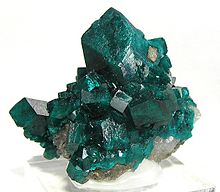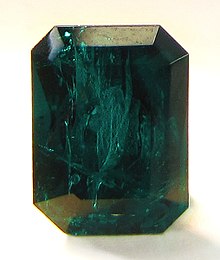Dioptase
| Dioptase | |
|---|---|
| Dioptase on calcite from Tsumeb, Namibia | |
| General and classification | |
| other names |
Copper emerald |
| chemical formula | Cu 6 [Si 6 O 18 ] • 6H 2 O |
|
Mineral class (and possibly department) |
Silicates and germanates - ring silicates |
|
System no. to Strunz and to Dana |
9.CJ.30 ( 8th edition : VIII / E.21) 61.01.03.01 |
| Crystallographic Data | |
| Crystal system | trigonal |
| Crystal class ; symbol | trigonal-rhombohedral; 3 |
| Space group | R 3 (No. 148) |
| Lattice parameters | a = 14.57 Å ; c = 7.78 Å |
| Formula units | Z = 3 |
| Physical Properties | |
| Mohs hardness | 5 |
| Density (g / cm 3 ) | measured: 3.28 to 3.35; calculated: [3.30] |
| Cleavage | completely according to {10 1 1} |
| Break ; Tenacity | shell-like to uneven |
| colour | blue-green, emerald green, turquoise |
| Line color | weak green-blue |
| transparency | transparent to translucent |
| shine | Glass gloss |
| Crystal optics | |
| Refractive indices |
n ω = 1.644 to 1.658 n ε = 1.697 to 1.709 |
| Birefringence | δ = 0.053 |
| Optical character | uniaxial positive |
| Pleochroism | weak: dark emerald green, light emerald green |
| Other properties | |
| Special features | sensitive to heat or sun (dark discoloration) |
The mineral dioptase , often referred to as copper emerald or siliceous copper emerald because of its mostly deep green color , is a rather seldom occurring ring silicate from the mineral class of " silicates and germanates ". It crystallizes in the trigonal crystal system with the composition Cu 6 [Si 6 O 18 ] · 6H 2 O.
Dioptas mainly develops short to long, prismatic crystals , but also granular aggregates in the colors emerald green to turquoise . A glass-like sheen appears on the surfaces of the transparent to translucent crystals . Its Mohs hardness of 5 also corresponds to that of glass or the reference mineral apatite , so it can be scratched with a knife.
Etymology and history
The mineral was first mentioned in 1793 by Jean-Claude Delamétherie , who, however, was deceived by its emerald green color and thought it was a variety of emerald and accordingly referred to it as Emeraudine . The mineral then in 1797 by Haüy, who for the mineral's name was correctly described Dioptas of Greek διοπτεία for passage perspective chose. Dietrich Ludwig Gustav Karsten and Christian Samuel Weiss translated Haüy's derivation as follows:
“If one holds a dodecahedral dioptase up to the light, one perceives very clearly reflective points inside which go parallel to surfaces which, as far as can be seen, run parallel to the end edges; so that one can recognize the passages of the leaves in advance at these reflecting points, whereby the crystal, to put it this way, is queerly cut through. This is what the name Dioptas expresses. "
Accordingly, the name refers to the property that the inner gap areas can be seen due to the light reflections.
As type locality which is considered the deposit of "Altyn-Tyube" (Altyn-Tube) on the river Altyn-Su province Karaganda in Kazakhstan.
classification
Already in the meanwhile outdated, but still in use 8th edition of the mineral classification according to Strunz , the Dioptas belonged to the mineral class of "silicates and germanates" and there to the department of " ring silicates (cyclosilicates)", where together with chrysocolla it formed the independent group VIII / E .21 made.
The 9th edition of Strunz's mineral systematics , which has been in effect since 2001 and is used by the International Mineralogical Association (IMA), also assigns Dioptas to the class of “silicates and germanates” and there to the “ ring silicates (cyclosilicates)” category . However, this section is further subdivided according to the type of ring formation and the possible presence of further anions , so that the mineral can be found in the subdivision "[Si 6 O 18 ] 12− -six simple rings without island-like, complex anions" according to its composition where it is the only member of the unnamed group 9.CJ.30 .
The systematics of minerals according to Dana , which is mainly used in the English-speaking world , assigns the Dioptas to the class of "silicates and Germanates", but there in the more finely subdivided division of "ring silicates: six rings". Here he is the only member of the unnamed group 61.01.03 within the subdivision “ Ring Silicates: Six Rings with Si6O18 Rings; possible (OH) and Al substitution ”.
Crystal structure
Dioptas crystallizes trigonal in the space group R 3 (space group no. 148) with the lattice parameters a = 14.57 Å and c = 7.78 Å as well as 3 formula units per unit cell .
Structurally , Dioptas consists of strongly deformed [Si 6 O 18 ] -silicate rings, whose narrow channels of only 1.77 Å, in contrast to the zeolites, cannot so easily escape or absorb the water of crystallization . However, it can be driven out by careful heating. The crystal structure of Dioptas shows that the six tetrahedral silicate anions are connected to the silicate ring via their oxygen atoms. Cu atoms are coordinated to the oxygen atoms that are not involved in ring formation. The Cu atoms are coordinated equatorially by four oxygen atoms and also by two water molecules to form distorted octahedra. These octahedra are linked by common edges, so that the silicate rings are connected laterally and vertically to form a three-dimensional network. The octahedron is arranged in such a way that the water molecules align themselves in the direction of the silicate rings.
properties
The color of the mineral is determined by the energetic position of the dd transitions. These were measured using a UV - VIS spectrum and assigned reliably.
Dioptas is infusible in front of the soldering tube, but turns black. It is soluble in hydrochloric acid and ammonia , whereby silica ( kieselgallert ) separates out.
Education and Locations


Dioptase forms in the oxidation zone of copper deposits and in fissures of limestone , dolomite or sandstone , where it occurs in paragenesis with calcite , cerussite , chrysocolla , hemimorphite , malachite , mimetesite and wulfenite .
As a rather rare mineral formation, Dioptas can sometimes be abundant at various sites, but overall it is not very common. So far (as of 2011) around 150 sites are known.
Known for its extraordinary dioptase finds, in addition to its type locality Altyn-Tyube in Kazakhstan, Tsumeb in Namibia and Renéville in the Department Pool in the Republic of the Congo, where well-formed crystals of up to 5 cm in size emerged.
In Germany, the mineral was found in the Altenberg tin mine in the Saxon Ore Mountains, among other places . Another site, Sasel near Grebin am See in Schleswig-Holstein, has not yet been considered secure.
Other sites are found in Angola, Argentina, Australia, Chile, France, Iran, Italy, the Democratic Republic of the Congo, Morocco, Mexico, Namibia, New Zealand, Peru, the Republic of the Congo, Romania, South Africa, the Czech Republic and in several US states .
Synthetic manufacture
The synthesis of the pure silicate has not yet been successful. In contrast, the synthesis of the isotypic germanate Cu 6 Ge 6 O 18 · 6H 2 O and a germanate with up to 18 at% Si replacement for Ge is known.
use
As a mineral, dioptase is mainly of interest to collectors. It is rarely cut into gemstones for commercial use due to its relatively low hardness, good cleavability and, above all, its great sensitivity to any kind of heat influence (loss of crystal water makes the stone cloudy and dark) . The mineral can be confused with diopside , fluorite and emerald , among others .
See also
literature
- Jean-Claude Delamétherie : De la crystallisation d'une émeraude . In: Observations sur la Physique, sur l'Histoire Naturelle et sur les Arts . tape 42 , 1793, pp. 154-154 .
- RJ Haüy: Dioptase (NN), c'est-à-dire, visible au travers . In: Journal des Mines . tape 5 , 1797, pp. 274–275 ( rruff.info [PDF; 445 kB ; accessed on October 29, 2017]).
- C. Hauy: Sur la dioptase . In: Bulletin des Science, par la Société Philomathique . March 1798, p. 101 ( rruff.info [PDF; 208 kB ; accessed on October 29, 2017]).
- Walter Schumann: Precious stones and gemstones. All kinds and varieties. 1900 unique pieces . 16th revised edition. BLV Verlag, Munich 2014, ISBN 978-3-8354-1171-5 , pp. 210 .
Web links
- Mineralienatlas: Dioptas , Mineralienatlas: Mineralienportrait / Dioptas (Wiki)
- realgems.org - Dioptas (with examples of cut crystals)
- RRUFF Database-of-Raman-spectroscopy - Dioptase (English)
Individual evidence
- ↑ a b c d e f Hugo Strunz , Ernest H. Nickel : Strunz Mineralogical Tables. Chemical-structural Mineral Classification System . 9th edition. E. Schweizerbart'sche Verlagbuchhandlung (Nägele and Obermiller), Stuttgart 2001, ISBN 3-510-65188-X , p. 608 .
- ↑ Webmineral - Dioptase (English)
- ↑ a b c dioptase . In: John W. Anthony, Richard A. Bideaux, Kenneth W. Bladh, Monte C. Nichols (Eds.): Handbook of Mineralogy, Mineralogical Society of America . 2001 ( handbookofmineralogy.org [PDF; 66 kB ; accessed on October 21, 2017]).
- ↑ a b c d Mindat - Dioptase (English)
- ^ Walter Schumann: Precious stones and gemstones. All kinds and varieties. 1900 unique pieces . 16th revised edition. BLV Verlag, Munich 2014, ISBN 978-3-8354-1171-5 , pp. 23 (see rhinestones ).
- ↑ Franz Ambrosius Reuss : Textbook of Mineralogy, according to Mr DBR Karsten mineralogical tables . Friedrich Gotthold Jacobaer, Leipzig 1803, p. 476 ( limited preview in Google Book search).
- ↑ RJ Haüy: Dioptase (NN), c'est-à-dire, visible au travers . In: Journal des Mines . tape 5 , 1797, pp. 274–275 ( rruff.info [PDF; 445 kB ; accessed on October 29, 2017]).
- ^ Dietrich Ludwig Gustav Karsten, Christian Samuel Weiss: Textbook of Mineralogy . tape 3 . Reclam, Paris, Leipzig 1806, p. 174 ( digitized version ).
- ↑ Mindat - picture example of a dioptosis with split surfaces visible in transmitted light
- ↑ a b Friedrich Klockmann : Klockmanns textbook of mineralogy . Ed .: Paul Ramdohr , Hugo Strunz . 16th edition. Enke, Stuttgart 1978, ISBN 3-432-82986-8 , pp. 712 (first edition: 1891).
- ↑ PH Ribbe, GV Gibbs, M. Hamil: A refinement of the structure of dioptase, Cu 6 (Si 6 O 18 ) · 6H 2 O . In: American Mineralogist . tape 62 , 1977, pp. 807–811 ( rruff.info [PDF; 505 kB ]).
- ↑ Hans Hermann Otto: Crystal Growth of Cu 6 (Ge, Si) 6 O 18 6H 2 O and Assignment of UV-VIS Spectra in Comparison to Dehydrated Dioptase and Selected Cu (II) Oxo-Compounds Including Cuprates . In: World Journal of Condensed Matter Physics . tape 7 , no. 3 , 2017, p. 57-79 , doi : 10.4236 / wjcmp.2017.73006 .
- ↑ Mindat - Number of locations for Dioptas
- ↑ Hans-Jürgen Brandt, Hans Hermann Otto: Synthesis and crystal structure of Cu 6 [Ge 6 O 18 ] · 6H 2 O, a dioptase-type cyclo-germanate . In: Journal of Crystallography - Crystalline Materials . tape 212 , no. 1 , 1997, p. 34-70 , doi : 10.1524 / zkri.1997.212.1.34 .
- ^ Precious stone etiquette by Prof. Leopold Rössler - Dioptas




